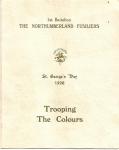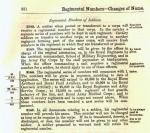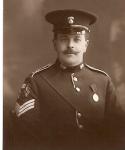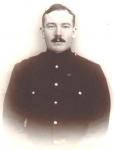-
Posts
1,065 -
Joined
-
Last visited
-
Days Won
1
Content Type
Profiles
Forums
Blogs
Gallery
Events
Store
Everything posted by Graham Stewart
-

Today's finds
Graham Stewart replied to Noor's topic in Great Britain: Orders, Gallantry, Campaign Medals
2720 Pte J.Byrne enlisted sometime between September 1888 and April 1889. -

Today's finds
Graham Stewart replied to Noor's topic in Great Britain: Orders, Gallantry, Campaign Medals
-

Unknown Regiment
Graham Stewart replied to Alex K's topic in Great Britain: Militaria: Badges, Uniforms & Equipment
Hi Ed - in this case I'm afraid not. The type of belt worn with the older and newer pattern 'BD', as we used to call it was the 1937 Pattern web belt. As an ex-DLI Army Cadet we were still wearing these uniforms and the belts well into the late 60's early 70's, long after the Army had gone over to No.2 Dress. I went onto to join the R.N. in 1976 and later saw our helicopter aircrewmen wearing the naval dark blue version 'BD' blouses in the late 70's. Irishgunner - sorry if my reply sounded a bit "offish". -

Unknown Regiment
Graham Stewart replied to Alex K's topic in Great Britain: Militaria: Badges, Uniforms & Equipment
In this case the R.A. "beret" badge is about two thirds the size(if that) of what we would normally recognise and more compact, so the detail you see on the larger "cap" badge as worn in the peaked cap isn't as prominent as you would expect. -

Unknown Regiment
Graham Stewart replied to Alex K's topic in Great Britain: Militaria: Badges, Uniforms & Equipment
Would agree that you're looking at a Gunner of the Royal Artillery, but the fact he's wearing a coloured beret and open necked battle-dress blouse with collar and tie for other ranks, would possibly suggest post-1945. -
From the same studio and around about the same time a Sergeant of the Northumberlands wearing what would be regarded as an outragous pattern of service dress, which has either been modified or is private purchase. The jacket has plain bomb collars and just visisble are a pair of metal titles, but even more noticable are the gold lace chevrons rather the more commonly seen khaki worsted. This is the second NF photo I have in which gold lace chevrons are worn and must pre-date the standard pattern of chevron worn with the 1902 pattern SD jackets.
-
Nice one and as far as I'm aware they were only ever made in silver, and I'm wondering if this has been plated as the back has the typical black verdigre, one would associate with silver. I was told that in the early 1980's some repro officers TS shoulder titles had made there way onto the market, but how true this was, I honestly couldn't say, because I never saw that many TS officers titles in all of the fairs I ever visited.
-
Don't you just love it when something really nice turns up - in this case a lovely CDV studio portrait of an unknown officer of the Northumberland Fusiliers, wearing the peaked "station master" pattern forage cap and dark blue "frogged" patrol jacket which is not often seen. The image possibly dates to around the 1890's and was taken at the studio of "T.Winter of Murree & Pindee".
-

broken British War Medal
Graham Stewart replied to Noor's topic in Great Britain: Orders, Gallantry, Campaign Medals
Noor - Only the 5th(Service) & 6th(Service)Battalions of the R.Irish Regiment began a new numbering series from '1' in August 1914. The regulars as this point were unsing five figure numbers, which makes me a bit curious, as to how quickly James was sent to the front as a reiforcement?? The 3rd(Reserve) & 4th(Extra Reserve)Bn's had their own numbering sequence, and men in these battalions were known as "Special Reservists". The number "6969" used by James was first issued sometime in 1900/1901, so I'm wondering if James was either a pre-war regular, recalled as a Reservist or was he a "Special Reservist" called up, as they were to reinforce his regular colleagues??? In the first case - if he was a former regular on the Reserve, he would have kept his old number. As a Special Reservist again the number would have been issued on enlistment into the 'SR' pre-war. Going off my own Northumberland Fusiliers experience, lads who enlisted in August/September 1914 rarely went to regular battalions as reiforcements unless having previous military experience(i.e. Discharged former ex-regs). Whereas the "Kitchener Army" lads, who had to undergo military training, don't start appearing overseas until the middle/back end of 1915, the exception being Territorials. So my instincts are telling me he's either a pre-war regular or Special Reservist. -

Gordon F.S. helmet hackle
Graham Stewart replied to jf42's topic in Great Britain: Militaria: Badges, Uniforms & Equipment
Hi mate - know what you mean - different forums, same questions even though the enquirer may be new to the subject. Apart from Barthorps Book and the Osprey Series of books, I don't think anything has been produced in book form in the last twenty years giving us the definative answers we require. I believe Grumpy may be considering doing something with scarlet, as I've supplied him with some photo's from my collection of the NF's in various patterns. Have you checked out the "Northumberland Fusiliers" topic's yet in this Forum - contains stuff from my collection. -

Gordon F.S. helmet hackle
Graham Stewart replied to jf42's topic in Great Britain: Militaria: Badges, Uniforms & Equipment
The H.L.I. apart you'll find that the Light Infantry regiments followed the dress codes of the other line regiments. Of those L.I. regiments only the Durham L.I. and Ox & Buck's L.I., converted to white facings in 1881. The other's being "Royal" regiments had blue facings. After 1900 it would appear that only the D.L.I. went onto adopt dark green facings and I'm certain their caps would have followed the same pattern as the remainder. As for the Rifles - I couldn't honestly say, but it's likely that they may have adopted a similar pattern to "blues" but in Rifle green. Hopefully I'll be able to direct you to a site that is outstanding in it's approach to photographs of the British Army at the turn of the century. Soldiers of the Queen;- http://www.soldiersofthequeen.com/ -

Gordon F.S. helmet hackle
Graham Stewart replied to jf42's topic in Great Britain: Militaria: Badges, Uniforms & Equipment
My error again - the 1902 pattern peaked forage cap for other-ranks wasn't coloured, but seemingly black or very dark blue throughout. It doesn't even appear to have coloured piping on the crown. The attached photo shows the one you mean, worn by Colour Sgt Boyd, 6th Bn, Northumberland Fusiliers prior to the Great War. Sorry for my errors, but I'm thousands of miles from my notes and trying to remember it all off the top of my head. -

Gordon F.S. helmet hackle
Graham Stewart replied to jf42's topic in Great Britain: Militaria: Badges, Uniforms & Equipment
Blue's seem to turn up around 1900, but there's still some debate about their introduction as one of our members has done extensive research into British Army uniforms and prior to 1937 they were not an "issue" item. They were either a regimental purchase or private purchase, but the number of photo's we see where they are worn, would make them an expensive purchase, even at regimental level. I even have a photo of a R.F.A. lad and Northumberland Fusilier posing together in India pre-WWI, and the R.F.A. lad is wearing "blues", with the addition of braiding on the cuff, which shows that there was no uniformity from unit to unit, especially where the pocket patterns were concerned. Interesting that you should mention the coloured peaked forage cap introduced c.1902 for other ranks, as the overall colour of that was blue and although seen often with scarlet, would have suited wear with blues better. -

Gordon F.S. helmet hackle
Graham Stewart replied to jf42's topic in Great Britain: Militaria: Badges, Uniforms & Equipment
-

Gordon F.S. helmet hackle
Graham Stewart replied to jf42's topic in Great Britain: Militaria: Badges, Uniforms & Equipment
I would think that it would possibly reflect what was worn in the feather bonnet. For instance the Royal Highlander Regt(Black Watch) wore the red hackle, again I believe reflecting that worn in the feather bonnet. -
I'm not familiar with Canadian uniforms either, but it was interesting to note that the original dark blue collar seemed to have been overlayed with a lace one at a later date. The stamping's on the interior of the jacket and the hessian interior are in line with similar other ranks pattern British scarlet jackets that I have in my collection, although the Clothing Department here also placed paper size labels in them too. The material overall seems to be Melton cloth, which is the same material used in the manufacture of British jackets too I also wonder if the purpose of adding the overlayed lace collar, was to turn the jacket from a plain other ranks into perhaps a bandsmans jacket???
-

Victory Medal
Graham Stewart replied to Hauptmann's topic in Great Britain: Orders, Gallantry, Campaign Medals
Cap badge displayed with the medal is the post-1953 other ranks badge - the Royal Marine Artillery had their own distinct helmet plate and cap badge. During WWI the badge worn in the service dress cap was infact a flaming grenade(can't remember the number of flames), the ball being plain in gilding metal. -

Photos Royal Inniskillin Fusiliers
Graham Stewart replied to Noor's topic in Great Britain: Research, Documentation & History
Two Sergeants; Home in on the pagree flash of the lad seated as one of our Skins researchers may be able to identify it. Definately post-Great War, but no later than 1929/30 at a guess. I'm also sure the regiment produced a regimental magazine during this period, which could probably help you out, considering overseas stints then lasted for years and not months.









